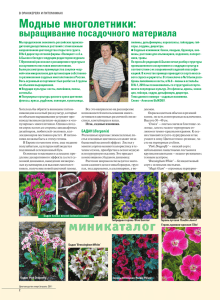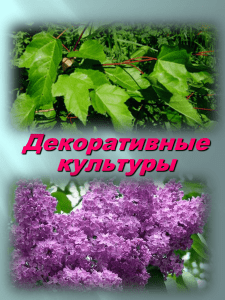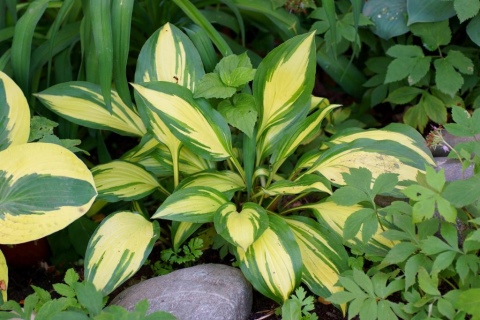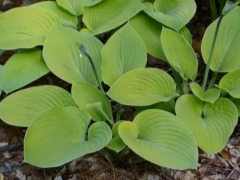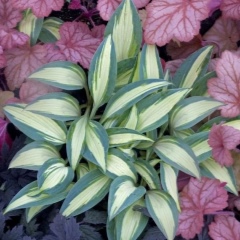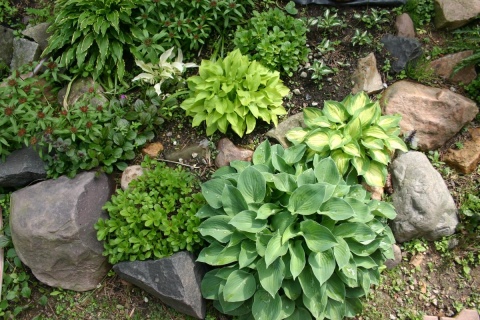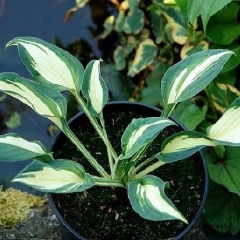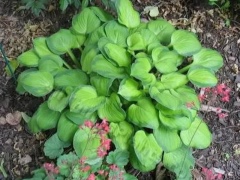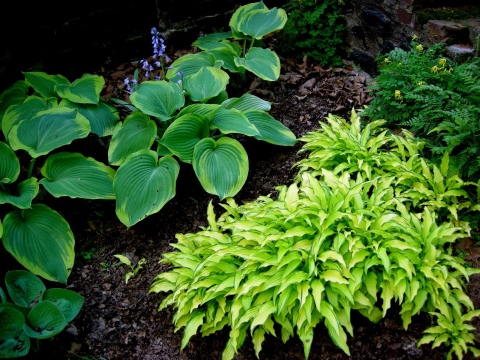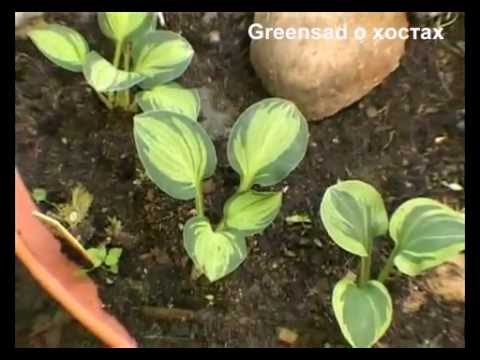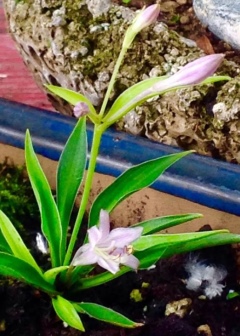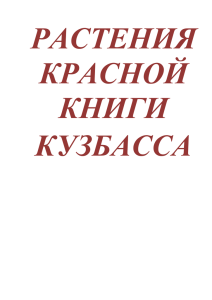Growing rules
Hosta elegans is an undemanding plant. Caring for her is not difficult, but must be done correctly.
Hosta elegans shows its decorative properties best when planted in the shade or partial shade.
Fundamental rules:
Hosta elegans loves moist soil, but without stagnant water. It is necessary to water it in a timely manner, making sure that the ground at the roots does not dry out - about 1 time in 3-4 days. It is best to do this in the morning or evening. Excessive moisture at the roots can cause rotting.
Hosta elegans is fed three times during the season, alternating mineral fertilizers with organic
It is advised to observe this regime: for the first time in spring, when the period of its active growth begins, then during flowering and after its end.
Loosening the soil under the hosta elegans should be done with caution. The roots of the plant are very close to the surface of the earth, so it is easy to injure them.
It is best not to loosen, but to mulch the soil, especially since the hosta practically leaves no room for the weeds to grow.
Preparing for winter
Although hosta elegans has good frost resistance, it also needs to be prepared in a certain way for the onset of winter. The set of necessary measures depends on the climate in which it grows. The more severe winter is expected, the more responsible you need to approach the organization of special care during this period.
Preparing the elegans hosts for winter includes the following activities:
- In the fall, after the plant has faded, it is necessary to prune it. Some gardeners remove only flower stalks, but at the same time leave dying foliage on the bush so that in winter it additionally covers the roots of the plant. Another part of gardeners in the autumn period necessarily cuts off all yellowed leaves from the hosta. They motivate their actions by the fact that slugs and snails usually spend the winter in old foliage, which, waking up in spring, will begin to actively eat young greens. The specific dates when the elegans host should be pruned are usually not named, but it is advised to carry it out two to three weeks before the expected cold weather.
- Top dressing Elegance is not carried out in the autumn. Phosphorus-potassium compounds applied to the soil in mid-July and early August help the plant recover after flowering and prepare for the cold weather.
- Before the onset of winter, the soil under the hosta elegans is mulched with a layer of humus or peat about 15-17 cm thick. If severe frosts are expected, you can additionally cover the bush with coniferous spruce branches or "breathing" agrofibre.
Some growers recommend pruning the yellowed and withered foliage of the hosta for the winter, others advise leaving it as a winter shelter for the roots.
Features of planting and care in the open field for unusual hosts
The host is considered a plant for the lazy, and yet the basic rules of planting and care in the open field should be followed.
Important! The lighter the color of the foliage, the better the planting site should be illuminated.
- the time for planting is early spring or October, the place must be chosen taking into account the variety;
- planting material should be cleaned of damage and rot and treated with a special preparation that stimulates growth and root formation;
- it is better to fertilize the soil in autumn with organic matter, and if this was not done, then complex fertilizer is applied to the holes;
- the distance between the holes should be equal to the height of the future bush, the holes should be wide enough to accommodate the straightened roots;
- then cover the measles with earth, compact and water.
Valuable varieties need to be looked after especially carefully, not allowing the soil to dry out. Feed only with special complexes according to the instructions attached to them.
Attention! Valuable collectible varieties during the first 2-4 years may not show their signs. They can be transplanted only after 5-7 years.
Hosta flowers, planting and care
Landing
The best time for this procedure is early spring or late summer (August-September)
When purchasing a plant, pay attention to the roots: they should be 10-12 cm long and elastic, and the sprout with 2-3 buds
When buying a bush early, when it is not yet time for planting, the seedling should be placed in a dark and cool (+5 degrees) place. This can be a basement, cellar, insulated balcony or refrigerator.
Landing place
It should be in partial shade. But it is noticed that the lighter the leaf of the seedling, the lighter the area should be. That is, plants with dark or blue foliage are planted in shady places, and light varieties can be planted in partial shade, but direct sunlight can cause leaf burns.
The soil for the culture should be light, fertile and moist. The planting hole is dug widely and up to 30 cm deep. The distances between the holes are 50-100 cm, depending on the variety.
The hole is filled 2/3 with peat, compost and a seedling is placed on the resulting mound, carefully spreading the roots, covered with earth and compacted. Then the planting is watered and watering is repeated every 3-4 days. It is worth planting to mulch.
Hosta care
Although the plant is undemanding, for successful cultivation it is still necessary to pay a minimum of attention to it.
- Weeds are regularly weeded and the soil is loosened around, especially for seedlings. Mature plants do not suffer from weeds.
- Watering in dry time should be carried out 2 times a week in the morning, as the culture is hygrophilous. Especially young plants need moisture. With a lack of water, the tips of the leaves darken at the bushes.
- Old leaves are removed, as well as young arrows - the plant will look better, otherwise it may fall apart. Arrows are left in varieties with beautiful flowers.
- Although the hosta can grow in one place for up to 20 years and grow great at the same time, it is advisable to transplant it every 3-4 years, separating cuttings with heels or delenki from the bush in order to plant in a new place.
- The culture is winter-hardy, but for reliability, you can close it with a covering material in late autumn.
- Mulching plants in autumn with humus and compost helps not only to overwinter, to retain moisture in the soil, but is also a source of nutrients.
- Plant feeding without mulching is carried out three times per season: at the beginning of the growing season, flowering and after it. It is good to apply complex mineral fertilizer after watering or rain.
Reproduction
- The culture is mainly propagated by dividing the bush, cuttings and seeds.
- The division is carried out in the spring in May or at the end of August. The smaller the cut, the longer it will take for the bush to grow well.
- Blacking is the separation from the bush of a cuttings with a heel, that is, with a part of the rhizome. Cuttings are planted immediately in the right place, watered and necessarily shaded.
- Growing from seeds is a long and rather complicated process. And such reproduction does not guarantee the preservation of the basic properties of the mother plant.
Possible problems
Although the hosta practically does not get sick, however, growing for a long time in one area increases the likelihood of disease. Without proper care, plants become weak and can get sick with a fungal disease - phyllosticosis, when the foliage becomes covered with yellow spots. Such bushes are dug up and destroyed, and the earth is disinfected.
Much damage to the culture is caused by slugs, which eat holes in the foliage. Read how you can fight slugs.
variety of hosts
Application in landscape
Hosta will perfectly decorate the shore of any body of water, along with roses planted on the south side. It is used to frame lawns, decorate paths and paths in the garden, and use it as a ground cover plant for areas in the shade. The host is a plant for a flower garden, but in containers it will decorate both the yard and the veranda. Together with phloxes and daylilies, it will also decorate vertical beds.
The host looks harmoniously with ferns, heuchera, primrose, geranium, astilba, foxglove.
With any method of decorating a garden plot, host flowers, planting and caring for which are not difficult, will captivate you with their charm and beauty. Plant this plant with beautiful foliage and you won't regret it.
I invite you to the group for "Country Hobbies"
Description of popular varieties of hosts
Among the most purchased varieties of host are primarily varieties, the leaves of which are colored in gray, bluish and other colors other than the traditional green. Varieties with various veins or spots are in special demand.
The most popular varieties include the following:
- Thunderbolt or Thunderbolt is a vigorous host with dense foliage. The leaf plates are painted in bluish tones, with a white stripe running in the center of the leaf, which turns yellow by the end of summer. It is a shade-loving plant that overwinters well in large containers. The height of the bush is 50-60 cm, the width is 70-80 cm. The preferred type of soil: loose, drained, except for dry sandy ones.
-
First Frost is a medium-sized spreading variety of the “chameleon” group. He belongs to this group for the peculiarity of the leaves - during the season they change their color from gray to rich green. The name of the variety is translated as "First Morozets". Hosta is so named for the fact that it does not lose its attractive appearance until the first frost. Plant height reaches 50 cm, width - 60-90 cm. Leaves are oval, with a pointed tip and heart-shaped base, dense, gray-blue with a yellow border. The flowers are light purple. The plant prefers fertile, moist soils.
- hosta Sumand Substance is a giant hosta growing up to 1 m in diameter. This is the owner of huge leaves of a bright yellow-green color. The surface of the sheet plate is corrugated. The main advantage of Sam and Substens is its unattractiveness to pests, but this variety is quite picky about watering and regular feeding, unlike many others. Sam and Substance blooms with large pale lavender flowers with a rich sweet scent of lilies. The variety is very winter hardy.
- Captain's Adventure is a highly decorative host. The leaves are in the form of a small rosette, the color is yellow-green. The edges of the leaf plates are colored dark green. Capitance Adventure develops well in diffused lighting. Growth - 50–55 cm. Lavender flowers. Hosta changes shade depending on growing conditions. It is better to plant Kapitans Adventure on moderately moist soils.
- Hosta Lakeside Dragonfly is a moisture-loving compact variety with oblong bluish leaves. The edges of the leaves are bordered by a creamy stripe. This hosta blooms with small purple flowers. The variety grows strongly. Flower size: up to 8 cm. Plant height: up to 30 cm. The high winter hardiness of this hosta variety allows you to grow the plant in regions with severe winters without problems. Lakeside Dragonfly is planted in fertile, drained soils.
-
Ty Rex (TRex) is a giant shade-tolerant host, blooming with large white flowers. The leaves of the variety are gray, corrugated. Plant height is more than 70 cm. In width the bush grows 180 cm, fully reaching varietal qualities for 4-5 seasons. The flowers are light lilac. Te Rex prefers slightly acidic soils.
- So Sweet is a compact host with very fragrant flowers. A distinctive feature of the variety is the characteristic sharpness of the leaves, bordered by a light thin strip. The plant grows equally well both in the sun and in the shade, however, areas with an openwork shade are best suited for growing the Sow Sweet species, since in such conditions the bright color of the foliage is well manifested.
- Blue Ivory is an ornamental variety with bluish leaves surrounded by a creamy border. By autumn, this strip becomes snow-white. Blue Ivory is shade-loving and medium-sized (up to 50 cm in height). The leaf is thick. It develops well in the sun and in openwork shade. Prefers light, loose, moderately moist soils.
- hosta Liberty is a bright, vigorous variety with dense foliage. Leaves are cordate, with a wide golden stripe along the edge.With age, the yellow edging fades to creamy white and expands, practically displacing the green color. The plant is light-requiring and does not tolerate shade. Flower size: up to 8 cm. Plant height: up to 1 m. The only drawback of this variety is its very slow growth.
- Little White Lines is a miniature host with white and green foliage. The variety is usually planted in small containers or pots. Plant width - up to 46 cm. Plant height: up to 20 cm. This variety must be divided every 3-4 years. Otherwise, it turns green and loses its decorative effect.
Planting methods
 Choosing a place for planting funkii
Choosing a place for planting funkii
So that the plant does not hurt, pleases with lush flowering - study in advance how the hosta is grown:
- A place. Choose partial shade for the bush - under the canopy of trees, near a stream, lake, in the lowlands of the site. The growing area must be protected from strong winds.
- Landing time. Start rooting the plant in spring - April or early May. Spring planting of hosts is also possible - from late August to mid-September. The function must have time to take root before frost. For autumn work, there is no need to prepare the soil in advance, just water the host abundantly 2-3 hours before planting.
- The soil. Hosta likes loamy or podzolic soil with a sandy layer on the surface (10 cm). Growing flowers should take place in soil with a pH of 6.5-7.5. Prepare the soil in the fall - scatter garden compost, leaf soil, wood ash, bone meal or rotted manure with a layer of 10 cm, dig up the soil to the depth of a shovel bayonet.
Planting material should be 10-12 cm long with elastic roots. Choose bushes with 2-3 buds. Place plants 30 to 80 cm apart. Gaps of about 100 cm are made between the spreading varieties of the flower.You need to plant the host like this:
- Make wide holes, 25-30 cm deep.
- Fill each hole 2/3 with peat and compost.
- Place a bush in the center of the hole, straighten the roots, cover with soil, compact, pour abundantly.
There are three ways of breeding hosts - by dividing the bush, cuttings and seeds. The first two are the most common. Bushes quickly take root after dividing a 5-year-old plant. Propagation by cuttings is a more traumatic method. The method of growing from seeds is not suitable for breeding hybrids, because seedlings do not inherit varietal traits.
Reproduction of hosts by seeds
 Seed host
Seed host
Start growing funky in April-May. Before propagating a flower, treat the material with a growth stimulant. A host from seeds at home is obtained like this:
- Disinfect the pots with potassium permanganate (0.5 g / 5 L of water) or alcohol.
- Pour drainage, moist fertile soil into containers.
- Spread the seeds on the surface of the ground, sprinkle with soil (5 cm layer), apply.
- Cover the container with glass or transparent film, put it in a shady, warm place - temperature + 18-25 degrees. Seedlings should appear after 3 weeks.
- Seedling Care - Keep the soil slightly damp at all times, and protect the seedlings from direct sunlight. After the appearance of 2-3 leaves, open the hosta - planting in fertile soil, covered with sand by 0.5-1 cm. Watering through the pallet. During the week, cultivation is carried out under a film with a large opening for air circulation. At an established temperature of +18 degrees, plant the flower in open ground.
Rhizomes
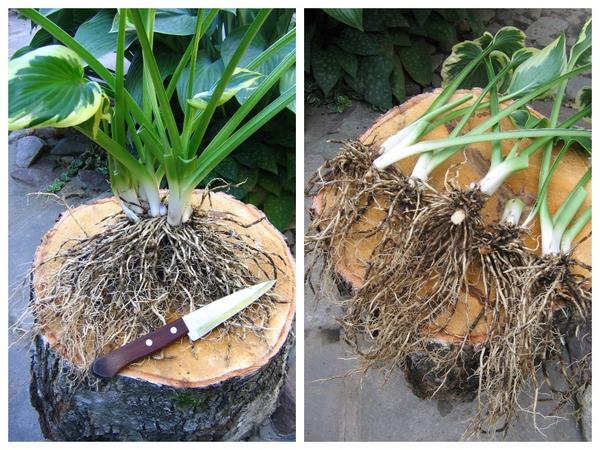 Division of the rhizome of the funkia
Division of the rhizome of the funkia
It is possible to transplant hosts in autumn or spring. Divide the shrub from 5 years old. Choose material with rhizomes about 10 cm long, with 2-3 growth buds. Purchased roots should be flexible and free from rot, mildew, stains and unhealthy growths. Planting is done immediately after dividing the bush, buying rhizomes. The material can be stored in a dark, cool place (temperature 5-10 degrees) in winter. To do this, place the roots in a transparent container or bag.
Cuttings
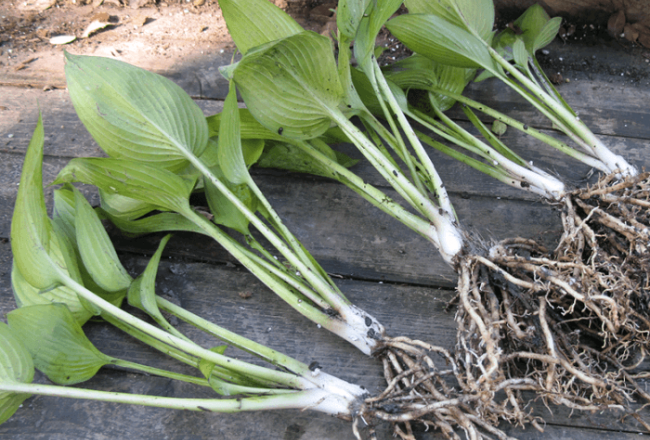 Funkia cuttings
Funkia cuttings
Reproduction is carried out in spring and early summer. Separate a bunch of leaves from an adult plant with a "heel" - with a cut of a fragment of the rhizome. Planting bushes is carried out immediately.If there are a lot of leaves, cut them in half - this will help the plants to root quickly. After planting, water the cutting abundantly, protect from the sun for 2-3 days.
Landing
When choosing a place for planting Serbian spruce, you should take into account its size in adulthood. It is desirable that there is nothing superfluous over the crown of the seedling - plants, buildings, crossbars. Adequate illumination of the landing site is an important but not decisive criterion. Although even shade-loving plants love the sun and space. Do not plant spruce in wetlands - too wet soil can destroy the root system.
For the rest, ate is absolutely picky about environmental conditions, the main thing is to plant them correctly from the beginning. Small seedlings can be planted in a pot. You can slightly improve the quality of the soil for the seedling - for example, add lime to the acidic soil, strengthen the loose soil with clay, and dilute the heavy soil with sand.
The process of single planting of Serbian spruce seedlings is as follows:
you need to prepare a pit, lightly fill the bottom with sand and rubble to get drainage;
set a seedling with neatly spread roots in the center of the pit, carefully cover it with soil (you can add sand and peat);
it is important to leave the root collar flush with the ground;
now you can water the plant.
In the event that spruce trees are planted in groups, the distance between them should be measured, depending on the variety:
- the distance between dwarf species is 50 cm-1 m;
- enough space for medium-sized varieties - 3-5 m;
- large specimens will do well within 5 m of each other.
Note: the rest of the plants can be planted near omoriki, but taking into account that the falling needles will eventually cover the space around them. This can hurt some of the undersized neighbors.
Instructions for planting Serbian spruce in the video below.
Miniature host varieties
Miniature hosts reach a height of no more than 15 cm, and the area of their leaf plate does not exceed 36 cm2. In the past, breeders paid more attention to medium-sized plants, but in recent years they have pleased gardeners with a wide variety of miniature varieties.
Spectacular tiny bushes were immediately appreciated by landscape designers, whose experience we, ordinary summer residents, are gradually adopting.
Miniature varieties are perfect for creating mixed borders. The hosts blend beautifully with a wide variety of perennials and annuals, so these crumbs will look perfect in the foreground. They will create a spectacular border, and will also fit into the overall picture when decorating a small rock garden. To do this, you can use one miniature variety or increase the decorativeness of the composition by planting several different varieties in a certain order, differing in color and shape of the leaves.
In my garden, tiny hosts not only line the mixed flower garden, but also serve as a delightful backdrop for some ornamental shrubs. In the near-trunk circles of hydrangea, spirea and rhododendron, I planted several species of these babies, observing a certain sequence. Small hosts have grown over time, and now at the foot of the bushes there are dense multi-colored glades, similar to Persian carpets with bizarre patterns.
I also use miniature varieties for landscaping the open veranda of my country house. I plant them in hanging pots and pots, creating in each a separate unique composition. In this case, you can plant 2 - 3 varieties in one pot and play on the contrast of the shades of their leaves, or you can plant one variety along the edge of the pot and shade the beauty of an upright flowering plant located in the center.
I would definitely like to mention some of my favorite mini-hosts. Very decorative miniature cultivar Little Jay, which stands out from other plants due to the amazing variegated color of foliage. The bushes of this variety are compact, reaching a height of 10-15 cm, and a width of 20-25 cm. Lanceolate wavy leaves at the edges are painted in a bluish-green tint, and creamy white in the center. During the flowering period, the bush forms creamy yellow peduncles with lilac flowers. Little Jay tolerates shading beautifully and looks great in the foreground of a mixborder.
Tiny hosta made a lot of noise among gardeners ‘Blue mouse ears‘.
Thanks to its cup-shaped oval leaves of a rich blue color, it looks very original, it looks both in a planter and in a garden flower bed. The height of its compact bush does not exceed 15 cm, and during the flowering period, lavender flowers with dark purple blotches on the petals give the plant a special charm. This variety can be planted anywhere with different light intensities, but in bright sun the blue leaves will lose their color.
The miniature 'Lucky Mouse Ears' variety is striking in its beauty. Its dense leaves are almost round in shape and look amazing due to the unique color - blue-green in the center and creamy yellow at the edges of the leaf plate. This little hosta is perfect for planting in a shady corner of the garden.
No less spectacular hosta variety Lakeside Banana Bay is about 15 cm high. Its leaves are very decorative: they are painted bright yellow, and have a wide apple-green border around the edges. This small hosta will grow well in both sun and diffused shade and will be indispensable for creating a bright accent in mixed plantings.
Among my favorites, the 'Blue Moon' variety stands out, barely reaching a height of 15 cm and having small dense leaves with a waffle texture. The leaf blade of this hosta is heart-shaped with a pointed tip, colored blue. The variety is especially decorative during the period of abundant flowering, when the plant throws out many large lavender inflorescences that exceed the size of the bush itself. The 'Blue Moon' exhibits enviable pest resistance and thrives even in deep shade.
Buy perennials by mail in the online store
Hosta Halcyon (Halcyon). It is one of the bluest hosts. This plant perfectly keeps its color for a long time, up to the middle of summer. Hosta favorably stands out among other plants not only in appearance, but also in characteristics
Its deep blue and heart-shaped leaves attract attention. The leaves are large enough (16x10 cm) and have a dense texture, covered with deep longitudinal grooves
The flower stalks of the plant are practically not leafy, their height is about 80 cm. When blooming, the flowers have a funnel-shaped shape and a characteristic purple hue. Aromatic flowering, lasts about 21 days. The host's planting site is selected depending on the color of the leaves. Varieties with dark and blue leaves should be planted in shady areas protected from rain, only there the plants will retain their fresh appearance until autumn. Yellow-leaved varieties grow successfully both in sunny areas and in partial shade, but it is also desirable for them to provide light shading in the hottest midday hours.
Hosta Halcyon (Halcyon) Please note that the color and texture of the leaves are fully manifested in the host only in the 2nd year after planting. They should be planted taking into account the size in an adult state.
Otherwise, adult specimens with rosettes up to one and a half meters in diameter will eventually cover perennials growing nearby.
Hosta Halcyon (Halcyon) Optimum planting time - spring. The hosts are suitable for treated soil with neutral acidity. They should not be planted on sandy and heavy loamy soils. Poor soils need to be improved by adding humus, sand and various mineral fertilizers. The soil should be moist without stagnant water.
Host Halcyon (Halcyon) The host's root system develops in breadth, which must be taken into account when choosing neighbors.The recommended distance is at least 50 cm. Care consists in weeding, watering, loosening. Keeping the soil around the plant tidy will keep slugs away from the plant.
Hosta Halcyon Hosta Chalcedony is considered to be the perfect decoration for any garden. It looks great both in an ensemble with other plants, and in single plantings.
Buy Hosta Halcyon in Voronezh with delivery across Russia wholesale and retail in Florini nursery.
Hosta "Halcyon"
Height about 40 cm. Width from 60 - 90 cm.
Blooms from July to August. The flowers are light purple. One of the bluest host, keeps color well until mid-summer
Prefers to grow in shade and partial shade
The soil needs to be drained, fertile
Planting hosts with a closed root system.
Hosts are perennial herbaceous plants that can differ not only in the shape and color of the leaves, but also in size. Namely, depending on the group, hosts are planted for different purposes, so dwarf hosts can be wonderful ground cover plants, and giant hosts are used in single plantings. Therefore, when planting hosts, you need to take into account the size of an adult plant.
By height, they are divided into five main groups: dwarf (up to 15 cm), undersized (from 15 to 30 cm), medium (from 30 to 50 cm), tall (from 50 to 70 cm) giant hosts (over 70 cm).
Plants with green and delicate bluish leaves are best planted in shade and partial shade. Hosts with spotted or striped leaves prefer a well-lit area. Hosts with bright leaves prefer the openwork shade of trees. To plant the hosts, you need to dig a hole, the hole must be at least as wide as the diameter of an adult hosta. If the soil is poor, add compost, a layer of garden soil and a small amount of mineral fertilizers to the bottom. Hosta loves fertile light and breathable soil. Next, fill the hole with earth, without deepening the root collar and carefully spill the plant (when planting hosts with an open root system, it is advisable to place the rhizome on a mound poured in the hole so that the cord-like roots are neatly spread out and well covered with earth). Due to the large surface of the leaves, the plant evaporates a lot of water, so it needs to be watered in a timely manner. In one place, the host can grow up to 20 years, the older it is, the more decorative its leaves.
Hosta halcyon description
MINI HOSTS - NEW PRODUCTS OF THE LAST YEARS
Hosta Dragon tails ("Dragon tails") is a dwarf variety of unknown origin with narrow, elongated lemon-yellow wavy leaves.
Lutescent, in adulthood it forms an elegant golden bump. One of the best yellow hosts in its size range due to its highly wavy, frill leaves. Grows rapidly and multiplies easily. Good for creating spectacular flower borders.
Variety Itsy Bitsy Spider - one of the smallest host, which easily fits into a pot no more than 7 cm in diameter. It looks like an agave in miniature. Very gentle and capricious; only 5 cm high.
In a tiny variety Cameo height 10 cm, tiny green-blue leaves with a creamy feathery border and purple flowers!
Variety Candy Dish (2016), or, in our opinion, "candy bowl", is distinguished by petioles with brown specks, dark green dense, shiny leaves with a corrugated edge. Height no more than 35 cm. Extraordinarily good!
Hosta Sparkler - a bright representative of the "striped" varieties in the literal sense of the word. Green dense, shiny lanceolate leaves in the center are painted with white and salad feather-like strokes.
Variety Cherry tart ("Cherry cake") 25 cm high, with lanceolate leaves that look up; petioles and peduncles are red-brown in color, which is absolutely in the spirit of the latest trends in host breeding.
Little host Chorus girl (“Chorus girl”, 2016), 35 cm high, with rounded cupped wax leaves of a gray-yellow-green color, waffle texture, a wonderful, memorable variety.
TIP: it's better to look at mini-hosts up close, so planting these tiny plants in containers is considered a good idea.
Have Tortifrons (2002) height 15 - 20 cm, narrow glossy wavy, leathery dark green twisted leaves.This unusual little host was accidentally discovered in a Japanese garden.
Hosta Mini skirt ("Mini-skirt", 2014) - a representative of the "mouse" series, a wonderful miniature hostochka with heart-shaped, very dense (the breed is visible!), Thick, twisted leaves. The color is blue-green with a wide yellow-cream border.
Bright showy Fireworks ("Fireworks", 2001) - height 10-15 cm, dense lanceolate creamy white shiny erect leaves with a dark green border and uneven shading.
Original variety - Hands up ("Hands up") size S (height - 35 cm). Comes from the super popular Praying Hands, inheriting from the progenitor the vertical arrangement of arrow-shaped, rigid, twisted dark green leaves edged with a yellow border. Looks more like regular grass than hosta.
Hosta Little treasure (2008) will truly become a “little treasure” (15 x 20 cm) for your garden. It is a charming dwarf with narrow, bluish-green lanceolate leaves with a wavy edge. A narrow creamy strip runs along the center of the leaf, like an axis of symmetry, dividing it into two equal parts.
Variety Lightning Flash ("Flash of light") has lanceolate elongated waxy blue-blue leaves with cream and yellow shading and a red base at the petioles. Height - 30 cm.
The variety Lakeside little tuff beautiful creamy leaves with a bright green border almost without petioles, just like the extremely fashionable dwarf Hacksaw ("Hacksaw") with a highly assembled edge of the sheet, reminiscent of the teeth of a hacksaw, for which it got its original name.
The 2015 variety, with the extravagant name Electrocution, forms a tousled bump of twisted narrow green leaves trimmed with a thin yellow border.
The novelty that appeared in our catalogs in 2017 is Valleys ruffle shuffle ("Mixed ruffles") has bluish-green dense leaves with a white lining and ruffle frill along the edge and purple petioles.
Baby Leather and lace ("Leather and lace"), advertised as a 2017 novelty by suppliers, has a blue leathery leaf center trimmed around the edge with a light yellow frill. Another baby with a quite fair name "gorgeous" - Wonderful - appeared in 2017. This mini-hostchka forms a very dense bush of elongated lanceolate leaves, painted in a bright yellow color, turning into a chartreuse shade by the middle of summer.
Hosta for the delight of the gardener
Hosts, thanks to their incredible beauty, are becoming more common among gardeners. The decorativeness of the plant is given by bright, spectacular foliage, which, depending on the variety, can be painted in a wide variety of shades.
The hosta also fell in love with summer residents for the fact that it does not require special labor costs for care and is one of those rare crops that are able to develop well even in shade and transform the most unsightly and seemingly completely inappropriate places for growing with their presence.
Hosta looks great on its own, and in a group with other ornamental plants creates a unique composition. In addition, this herbaceous perennial will delight the gardener for many years without losing its attractiveness for more than 25 years.
Hosta is, without a doubt, one of the best ornamental foliage plants for a backyard. Especially by the way, it will be necessary to fill the shaded space in the adult garden. Hosta is able to reveal all her beauty and charm even in the shade.
When choosing one or another variety, whether it is miniature or giant, one should be guided by its individual characteristics and preferences for the intensity of illumination, and then over the years the beauty of the plant will only increase.
Varieties of miniature and dwarf host
In the group of miniature and dwarf hosts, almost all variety of color, pattern and shape of leaves are presented. Green:
- with flat round leaves - ‘Abiqua Miniature’, ‘Collector’s Choice’, ‘Floradora’, ‘Lakeside Neat Petite’;
- with oval and lanceolate - 'Tiny Tears', Hosta venusta;
- with shiny lanceolate - ‘Yakushima Mizu’;
- with a waffle texture - ‘Lakeside Lepreschaun’, ‘Cody’;
- with concave plates - ‘Teaspoon’, ‘Quilting Bee’;
- with narrow lanceolate leaves - ‘Saishu Jima’, ‘Bitsy Green’, ‘Sugar Plum Fairy’.
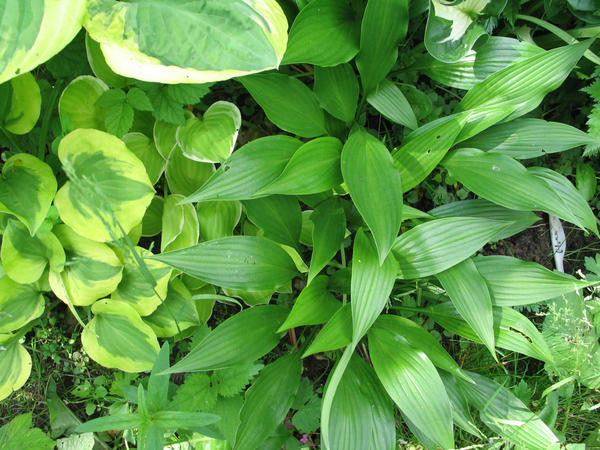 Hosta 'Hirao Splendor' Yellow:
Hosta 'Hirao Splendor' Yellow:
- with round leaves - ‘Cheatin Heart’, ‘Gold Drop’;
- with concave plates - ‘Limey Lisa’;
- with lanceolate leaves - 'Bitsy Gold';
- with wavy lanceolates - ‘Lemon Lime’, ‘Chartreuse Waves’, ‘Feather Boa’, ‘Royalty’, ‘Yellow Eyes’, ‘Yellow Waves’;
- with shiny smooth lanceolate - ‘Ga Ga’, ‘Subcrocea’, ‘Gosan Gold Midget’.
 Hosta ‘Lemon Lime’ Gray and blue:
Hosta ‘Lemon Lime’ Gray and blue:
- with round and oval leaves - ‘Abiqua Ground Cover’, ‘Baby Bunting’, ‘Popo’, ‘Tet-A-Poo’;
- with a waffle texture - ‘Blue Ice’, ‘Blue Moon’, ‘Blue Clown’;
- with concave, cupped plates - 'Blue Mouse Ears';
- with narrow lanceolates - ‘Rhythm and Blues’.
 Hosta ‘Blue Mouse Ears’ Co with light-bordered leaves:
Hosta ‘Blue Mouse Ears’ Co with light-bordered leaves:
- with round or oval leaves - ‘Crepe Suzette’, ‘Dew Drop’, ‘Lakeside Ninita’, ‘Thumbelina’, ‘Winsome’ (with white and cream border), ‘Mack the Knife’ (with orange border);
- with lanceolate leaves - ‘Crepe Soul’, ‘Hi Ho Silver’, ‘Dixie Chick’, ‘Little Bo Peep’, ‘Sparky’.
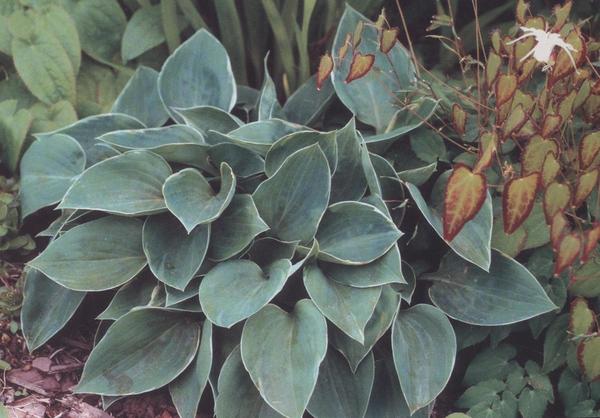 Hosta 'Dew Drop' With a light center of the leaf:
Hosta 'Dew Drop' With a light center of the leaf:
- with round or oval leaves - ‘Delia’, ‘Green with Envy’, ‘Little Caesar’, ‘Sitting Pretty’;
- with lanceolate leaves - ‘Fuji Sunrise’, ‘Green Eyes’, ‘Lakeside Elfin Fire’, ‘Medusa’.
 Hosta ‘Pandora’s Box’ With variegated, marbled leaves:
Hosta ‘Pandora’s Box’ With variegated, marbled leaves:
- with round and oval leaf blades - 'Artist's Palette' (with dense dark green leaves, cream border, cream and yellow strokes and stripes in the center), 'Lakeside Knickknake' (with dark green edges and a cream center mottled with yellow and olive strokes), 'Silver Treads and Golden Needles' (with green strokes on a yellow background);
- with narrow leaves - 'Little Jim' (with white and yellow stripes on an olive green background).
Hosta wavy Albomarginate - Sapling
319 rbl
.
Hosta Hybrid Gooseberry Sunday
400 rbl
.
Hosta Hybrid Tee Rex
242 rbl
Agrofirm Search
Hosta hybrid Monster Irz
210 rbl
Agrofirm Search
Hosta varieties
Hosta enjoys the love of gardeners. Indeed, in addition to natural varieties, a huge number of hybrids have been bred, which are divided into:
- Swollen hosts, which are distinguished by a heart-shaped leaf plate with a sharp tip. There are species of this plant, pleasing with a height of more than 100cm. In addition, these plants bloom with delicate light purple flowers.
Wavy, the color palette of which is difficult even to imagine. But all of them are united by the peculiar shape of the leaf plate. Oblong, elongated leaves seem to curl with sea waves. The largest varieties reach a height of up to 80 cm.
White-bordered - a variety, the leaves of which surprise with a white border, in the middle of which there are juicy greens. As a rule, they have an average height and very rarely exceed 30 cm.
Decorative - hosts that can bloom with lilac flowers. The leaf blade is usually dark green with a white edging.
Siebold. This hosta is blue with large, dense and wrinkled leaves that also pleases the eye with white blooms. Plant height - 40 cm.

